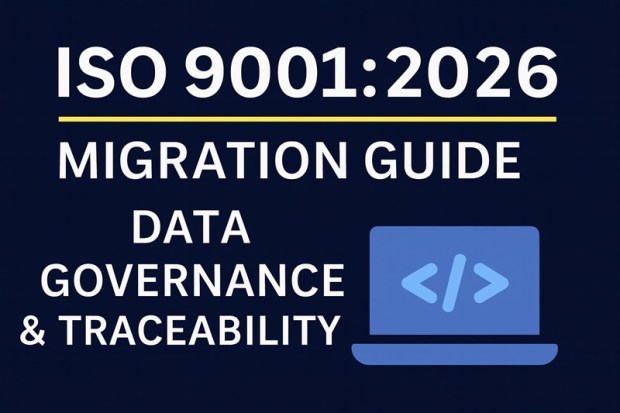The upcoming ISO 9001:2026 revision represents the biggest evolution since 2015, and one theme stands above all others: Data Governance and Traceability.
As digital systems increasingly drive decision-making, data integrity has become as critical as physical measurement.
The new version of ISO 9001 puts data control, validation, cybersecurity, and ethical use of digital information at the center of the Quality Management System (QMS).
If you want an overview of all major changes — from leadership and risk to sustainability — check out my full article:
👉 Why ISO 9001:2026 Isn’t Just an Update — It’s a Wake-Up Call for Quality Leaders
In this post, we’ll focus on how to prepare your QMS for ISO 9001:2026 data governance, and what it means for compliance, credibility, and culture.

📘 How ISO 9001:2026 Integrates Data Governance and Traceability
ISO 9001:2026 does not introduce a separate “Data Governance” clause, but instead weaves the concept across multiple areas of the QMS.
The focus has shifted from controlling documents to ensuring data accuracy, reliability, and traceability across digital systems.
| Clause / Area | How Data Governance & Traceability Are Integrated |
|---|---|
| Clause 3 – Terms & Definitions | 🧾 Adds new terms like data integrity, audit trail, traceability |
| Clause 7 – Support | 🧑💻 Requires validation of digital tools, data security, and system integrity |
| Clause 8 – Operation | 🔧 Expands traceability to include digital data flow and process records |
| Clause 9 – Performance Evaluation | 📊 Strengthens link between data analysis, KPIs, and decision traceability |
| Annex A – Guidance | 📘 Offers examples of implementing data validation in digital QMS tools |
The structure remains familiar, but ISO 9001:2026 data governance redefines how information supports quality — moving from “what’s written” to “what’s trusted.”
⚙️ What Does Data Governance Mean in ISO 9001:2026?
Historically, ISO 9001 traceability meant the entire measurement chain — from documented measurement instructions and calibration records to the traceability of materials used to produce a specific lot or batch. Today, that idea extends to the digital tools and datasets behind every quality decision.
- When you release a batch, you rely not just on gauges — but on digital dashboards consolidating measurements.
- In processes like curing cycles, composites, or precision machining, thousands of readings are captured by sensors and analyzed by algorithms, macros, or AI models before release.
- These systems must be validated, version-controlled, and auditable — just like any measuring device.
Auditors now ask:
“Can you prove your digital tools and dashboards are accurate, validated, and traceable?”
That’s the core of ISO 9001:2026 data governance — verifying the systems that generate data are as reliable as the data itself.
📄 From Document Control to Data Control
Earlier ISO 9001 versions focused on document control — revision, approval, and distribution.
Now, the same rigor applies to data control — how digital information is generated, used, and protected.
These are examples of what ISO 9001:2026 data governance brings:
- 🔢 Version control for software and databases. Using outdated software (e.g., CATIA V4 instead of V5) can cause compliance failures.
- 🔏 Protection against unapproved changes. Use audit trails, access restrictions, and tamper detection.
- ✍️ Strong digital signatures. Scanned stamps will give way to encrypted, identity-traceable e-signatures.
Considerations for organizations:
- Align data control procedures with document control principles.
- Define approved datasets and software versions.
- Build cooperation between IT and QA for cybersecurity and system validation.
- Larger firms should integrate ISO 27001 for full data protection.
- Smaller organizations can implement scalable, risk-based controls to stay compliant.
⚖️ Ethics and Fraud Prevention in Data Governance
As electronic data becomes the core of quality management, ISO 9001:2026 highlights the importance of ethics, transparency, and fraud prevention.
Key practices include:
- 🧭 Precautionary mindset: Encourage employees to question anomalies or suspect data.
- 🔍 Fraud-resistant design: Apply dual validation, cross-checks, and controlled access.
- 💬 Speak-up culture: Allow safe reporting of data vulnerabilities or manipulation.
- 🧑💼 Leadership accountability: Ensure top management promotes honesty and traceability.
Ethics and ISO 9001:2026 data governance go hand in hand — because technology can ensure traceability, but only people ensure truth.
🕵️ Real-Life Example: The Risk of Naive Digital Alteration
A real case shows why ISO 9001:2026 data governance is vital.
Elaine Thomas, a metallurgist in Washington State, falsified strength test data for U.S. Navy submarine steel over three decades.
The fraud surfaced after a submarine struck a harbor wall, triggering an investigation.
Analysts found that laboratory test cards were altered, producing false certificates that hid noncompliant results.
Consequences included:
- A $10.9 million settlement by the manufacturer.
- Costly re-testing of Navy submarines.
- Reputational damage and criminal prosecution of the individual.
This incident shows how even a small data falsification — done for convenience — can compromise safety, credibility, and careers.
ISO 9001:2026 data governance aims to prevent precisely this kind of failure.
🌐 Key Takeaway
ISO 9001:2026 data governance transforms quality management.
The future QMS will rely on verified data, controlled systems, and ethical behavior to build lasting trust in products, processes, and people.